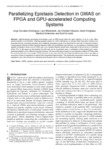Mostrar o rexistro simple do ítem
Parallelizing Epistasis Detection in GWAS on FPGA and GPU-Accelerated Computing Systems
| dc.contributor.author | González-Domínguez, Jorge | |
| dc.contributor.author | Wienbrandt, Lars | |
| dc.contributor.author | Kässens, Jan Christian | |
| dc.contributor.author | Ellinghaus, David | |
| dc.contributor.author | Schimmler, Manfred | |
| dc.contributor.author | Schmidt, Bertil | |
| dc.date.accessioned | 2018-08-16T10:34:08Z | |
| dc.date.available | 2018-08-16T10:34:08Z | |
| dc.date.issued | 2015 | |
| dc.identifier.citation | J. González-Domínguez, L. Wienbrandt, J. C. Kässens, D. Ellinghaus, M. Schimmler and B. Schmidt, "Parallelizing Epistasis Detection in GWAS on FPGA and GPU-Accelerated Computing Systems," in IEEE/ACM Transactions on Computational Biology and Bioinformatics, vol. 12, no. 5, pp. 982-994, 1 Sept.-Oct. 2015. doi: 10.1109/TCBB.2015.2389958 | es_ES |
| dc.identifier.issn | 1545-5963 | |
| dc.identifier.issn | 1557-9964 | |
| dc.identifier.uri | http://hdl.handle.net/2183/20968 | |
| dc.description | This is a post-peer-review, pre-copyedit version of an article published in IEEE - ACM Transactions on Computational Biology and Bioinformatics. The final authenticated version is available online at: http://dx.doi.org/10.1109/TCBB.2015.2389958 | es_ES |
| dc.description.abstract | [Abstract] High-throughput genotyping technologies (such as SNP-arrays) allow the rapid collection of up to a few million genetic markers of an individual. Detecting epistasis (based on 2-SNP interactions) in Genome-Wide Association Studies is an important but time consuming operation since statistical computations have to be performed for each pair of measured markers. Computational methods to detect epistasis therefore suffer from prohibitively long runtimes; e.g., processing a moderately-sized dataset consisting of about 500,000 SNPs and 5,000 samples requires several days using state-of-the-art tools on a standard 3 GHz CPU. In this paper, we demonstrate how this task can be accelerated using a combination of fine-grained and coarse-grained parallelism on two different computing systems. The first architecture is based on reconfigurable hardware (FPGAs) while the second architecture uses multiple GPUs connected to the same host. We show that both systems can achieve speedups of around four orders-of-magnitude compared to the sequential implementation. This significantly reduces the runtimes for detecting epistasis to only a few minutes for moderatelysized datasets and to a few hours for large-scale datasets. | es_ES |
| dc.description.sponsorship | London. Wellcome Trust; 076113 | es_ES |
| dc.description.sponsorship | London. Wellcome Trust; 085475 | es_ES |
| dc.language.iso | eng | es_ES |
| dc.publisher | Institute of Electrical and Electronics Engineers | es_ES |
| dc.relation.uri | http://dx.doi.org/10.1109/TCBB.2015.2389958 | es_ES |
| dc.subject | Field programmable gate arrays | es_ES |
| dc.subject | Graphics processing units | es_ES |
| dc.subject | Bioinformatics | es_ES |
| dc.subject | Random access memory | es_ES |
| dc.subject | Computer architecture | es_ES |
| dc.subject | Computational biology | es_ES |
| dc.title | Parallelizing Epistasis Detection in GWAS on FPGA and GPU-Accelerated Computing Systems | es_ES |
| dc.type | info:eu-repo/semantics/article | es_ES |
| dc.rights.access | info:eu-repo/semantics/openAccess | es_ES |
| UDC.journalTitle | IEEE/ACM Transactions on Computational Biology and Bioinformatics | es_ES |
| UDC.volume | 12 | es_ES |
| UDC.issue | 5 | es_ES |
| UDC.startPage | 982 | es_ES |
| UDC.endPage | 994 | es_ES |
| dc.identifier.doi | 10.1109/TCBB.2015.2389958 |
Ficheiros no ítem
Este ítem aparece na(s) seguinte(s) colección(s)
-
GI-GAC - Artigos [181]






